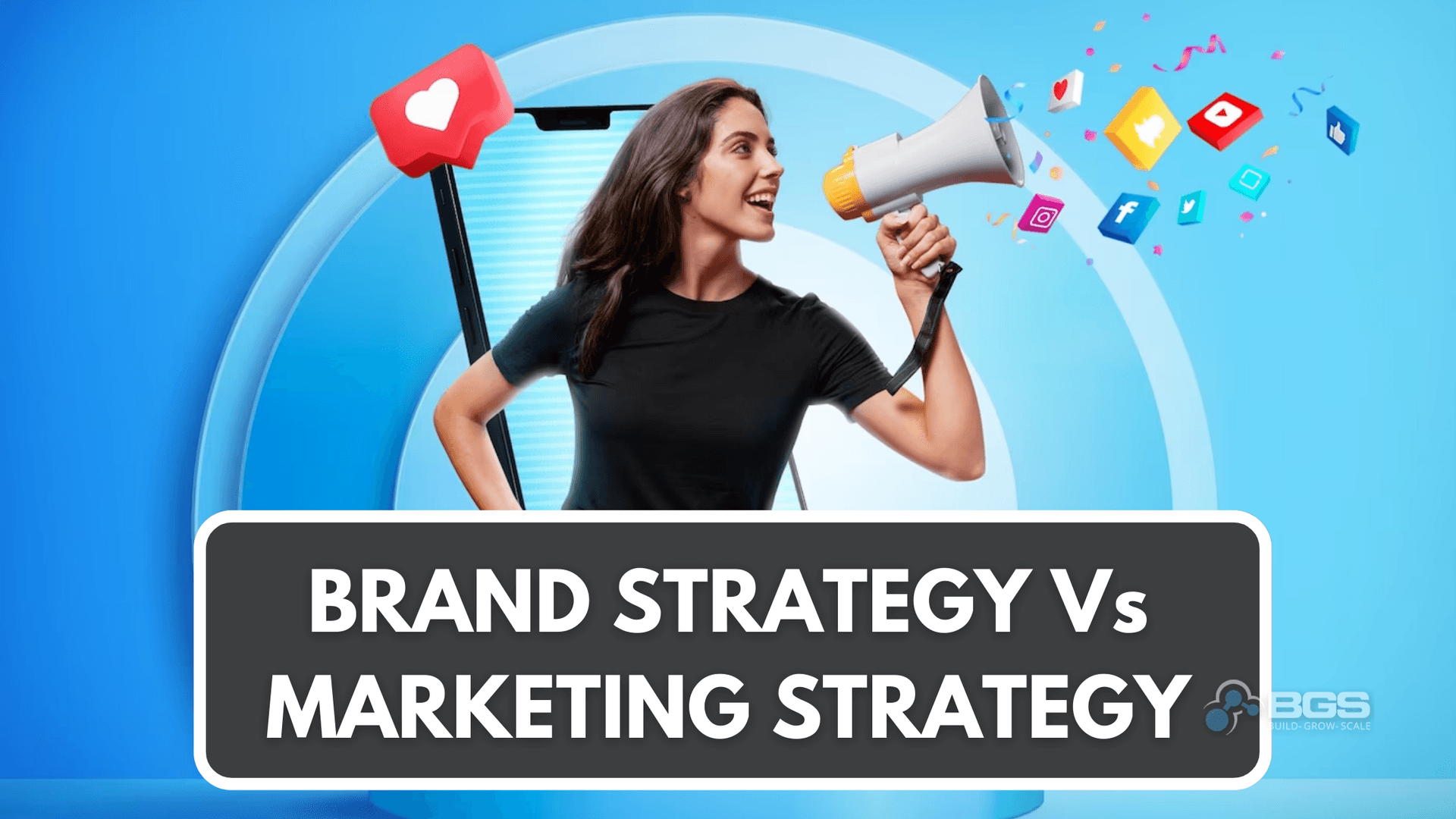Brand Strategy vs Marketing Strategy – What You Need to Know

Mariana Dourado | Sep 01, 2023
Reading Time: 6 minutesYou’re navigating the complex world of business strategy, but are you clear on the differences between brand strategy vs marketing strategy? It’s essential to understand these distinctions to drive your business forward effectively.
In this article, you’ll uncover what sets these strategies apart, how to develop each effectively, and the benefits of merging them for optimal business success.
Let’s dive in and demystify these strategic elements!
What Is a Brand Strategy
A brand strategy, unlike a marketing strategy, focuses on long-term goals. It’s the blueprint for creating a strong brand identity that resonates with your target audience.
Your brand strategy will define, among other things, your brand’s purpose, promise, and values. It’s not just about a catchy logo or tagline; it’s about forming an emotional connection with your audience. This strategy is fundamental in differentiating you from your competitors.
Brand identity, the tangible part of your strategy, is how your brand communicates with your audience visually and verbally. This includes your logo, color scheme, tone of voice, and overall message.
Then comes your target audience, the key players in your strategy. You need to know who they are, what they need, and how your brand can fulfill those needs.
Consider brand strategy vs marketing strategy. While marketing strategies are more about selling products or services, brand strategies are about creating a perception. They are about shaping how people see and feel about your brand.
What Is a Marketing Strategy
In essence, a marketing strategy is a plan that aids in reaching specific business objectives through carefully crafted advertising and promotional campaigns. It is a comprehensive game plan that you create to identify your business’s unique selling proposition, attract potential customers, and retain existing ones. The strategy includes elements such as market research, identifying your target audience, and positioning your brand.
Think of it as a roadmap that guides your marketing efforts. It is a strategic tool that helps you understand who your customers are, what they want, and how you can meet their needs better than your competitors. You can use different marketing channels such as social media, email marketing, SEO, and content marketing.
Remember, it’s not just about selling a product or service. It’s about creating value and building strong relationships with your customers. Your marketing strategy should focus on delivering the right message to the right audience at the right time. It’s about understanding the customer journey and making strategic decisions that lead to business growth.
Major Differences between a Brand Strategy and Marketing Strategy
You might be wondering how a plan to promote your business differs from the process of developing your company’s unique identity.
A brand strategy focuses on who you are as a company, while a marketing strategy outlines how you’ll convey that identity to your target audience.
Let’s break it down further. Your brand strategy is the backbone of your business. It’s your company’s mission, values, and unique selling propositions. It’s what sets you apart from your competitors and forms the basis of your customer’s perception of you. This strategy doesn’t change often, reflecting the core values and long-term goals of your business.
On the other hand, your marketing strategy is more flexible and goal-directed. It’s how you communicate your brand’s message to your audience using various channels and tactics. This strategy can change based on market conditions, customer behaviors, and business goals.
How to create a brand strategy
Crafting a unique identity for your company isn’t a process you should take lightly as it forms the foundation of how your audience perceives you. A brand strategy is more than just a logo or tagline; it’s the personality and promise of your business.
First, you must clearly define your brand’s mission, vision, and values. These are your guiding principles that’ll shape every decision, from design to messaging.
Next, identify your target audience. Consider their demographics, preferences, and pain points, which will guide how you communicate with them.
Once you’ve established these, it’s time to craft your brand’s voice, look and feel. This is where your creative instincts kick in. Create a unique, consistent style that resonates with your audience and differentiates you from competitors.
Your brand strategy doesn’t end here, though. You’ve got to consistently maintain and evolve your brand in response to shifting market trends and customer expectations. Monitor your brand’s performance, gather feedback, and don’t be afraid to tweak your strategy if necessary.
How to create a marketing strategy
Let’s dive into the next step: developing a winning plan to promote your products and reach your target audience. A well-designed marketing strategy is not just a luxury; it’s a necessity. So, where should you start?
Firstly, you’ve got to understand your market. Don’t simply assume you know your customers. Conduct market research to gather data on their preferences, habits, and needs. This information is crucial to formulating an effective marketing plan.
Secondly, identify your unique selling proposition (USP). What sets your product apart from the competition? You need to articulate this clearly in your marketing messages.
Next, evaluate your competition. Understand their strengths and weaknesses. This analysis will help you position your product effectively.
Lastly, develop a comprehensive promotional plan. What marketing channels will you use? Online, print, TV, radio? What’s the frequency of your ads?
Creating a marketing strategy requires careful analysis and strategic thinking. It’s not a one-time activity. It’s an ongoing process that needs constant tweaking and refining based on market trends and customer feedback.
How to merge a brand strategy and marketing strategy for your business success
Merging these two elements can significantly elevate your business success by creating a unified and compelling image for your company. When your brand strategy and marketing strategy are intertwined, it amplifies your company’s voice in the market, making you more recognizable to your audience.
The first step in this process is identifying your brand’s unique selling proposition (USP). It’s what sets you apart from the competition. Once you’ve defined your USP, you’re ready to weave it into your marketing strategy. Utilize your USP in every marketing message you put out there. It’s your brand’s core and should be the foundation of your marketing efforts.
Next, ensure that your marketing tactics align with your brand values. If sustainability is a core value of your brand, for example, your marketing strategy should reflect that. Maybe that means opting for eco-friendly promotional materials or supporting environmental causes.
Finally, consistency is key. Your brand’s voice, personality, and look should be consistent across all channels and touchpoints. This will reinforce your brand image in the minds of consumers, strengthening your overall market presence.
Following these steps will create a synergy between your brand and marketing strategies, driving your business towards success.
Final thoughts: Brand Strategy Vs Marketing Strategy
In conclusion, understanding the differences between brand strategy vs marketing strategy is crucial for your business success.
Creating your unique brand strategy helps define who you are, while a marketing strategy outlines how you’ll spread the word. Merging the two effectively can amplify your business success.
So, don’t overlook their importance – take time to craft, refine, and implement both for optimal results.
Frequently Asked Questions
When developing your brand strategy, it’s crucial not to overlook your target audience’s needs. Don’t rush the process, take time to define your brand comprehensively. Avoid inconsistency in your brand message, as it confuses customers. Don’t neglect the competition; understanding them can give you a competitive edge.
You can craft a potent marketing strategy even with a tight budget. First, understand your target audience well. Shape your products, services, and communication to meet their needs. Use social media platforms effectively; they’re cost-efficient and have a vast reach. Create engaging, relevant content regularly to attract and retain customers.
You should revisit your brand and marketing strategies at least annually. However, staying flexible and adjusting more frequently, if necessary, is crucial. Market trends, customer behaviors, and competitive landscapes change rapidly. Staying proactive will ensure your strategies remain effective and aligned with your business goals.
You can succeed with a robust marketing strategy, even if your brand strategy isn’t as strong. However, it’s not optimal. A strong marketing strategy can drive immediate results, but a weak brand strategy can hinder long-term growth and customer loyalty. It’s like having a car with a powerful engine but weak tires. You’ll move fast but won’t have the best control or longevity.



Table of Contents
What Is a Brand StrategyWhat Is a Marketing StrategyMajor Differences between a Brand Strategy and Marketing StrategyHow to create a brand strategyHow to create a marketing strategyHow to merge a brand strategy and marketing strategy for your business successFinal thoughts: Brand Strategy Vs Marketing StrategyFrequently Asked QuestionsTable of ContentsAbout the authorLeave a Comment Cancel ReplyAbout the author
Mariana Dourado
I am a Revenue Optimization expert for Build Grow Scale. I love doing research and finding low-hanging fruit on website analysis, and I'm sure clarity and consistency are a perfect match. I'm also passionate about the ongoing process that is Revenue Optimization. As a typical Brazilian, I love sports and going to the beach. All of my work is supervised by Shakira, my cute sausage dog, who requires a snack and a walk after each day of work.





